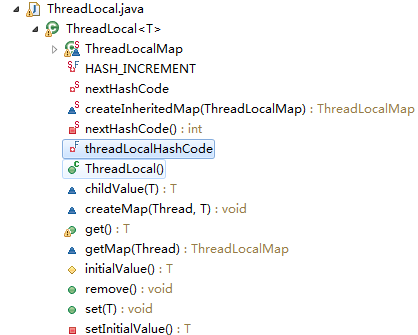这一篇之所以讲ThreadLocal,是因为之前在读Handler,Looper的源码过程(见http://maosidiaoxian.iteye.com/blog/1927735)中,看到了这个类,引起了我的兴趣。而后来
发现JAVA1.6中的TheadLocal类,和我在android源码看到的这个ThreadLocal类代码是不一样的。所以这篇先讲一下Java的ThreadLocal。
Java中ThreadLocal在Java1.2就已经提出了,后来重构过,所以我在想android中的这个类的实现是不是重构过之前的
版本优化过的,由于未找到早前版本该类的代码,所以只能进行猜测。
ThreadLocal用于提供
线程局部变量,即通过这里的get()和set()方法访问某个变量的线程都有自己的局部变量。但在这里需要注意的是,它是通过各个线程自己
创建对象然后调用这里的set方法设置进去,而不是由ThreadLocal自己来创建变量的副本的。就像上面链接的那一篇文章里面提到的android的Looper类所用的(虽然Android里ThreadLocal实现代码不一样,但用法是一样的),代码如下:
class="java" name="code">
static final ThreadLocal<Looper> sThreadLocal = new ThreadLocal<Looper>();
private static void prepare(boolean quitAllowed) {
if (sThreadLocal.get() != null) {
throw new RuntimeException("Only one Looper may be created per thread");
}
sThreadLocal.set(new Looper(quitAllowed));
}
可以看到,线程中的局部变量,是
在线程中创建,然后调用ThreadLocal.set()方法设置进去的。
下面详细读一下ThreadLocal这个类,看看它是怎么实现的(jdk1.6的源码)。

从上图可以看到ThreadLocal有三个变(常)量,代码如下:
/**
* ThreadLocals rely on per-thread linear-probe hash maps attached
* to each thread (Thread.threadLocals and
* inheritableThreadLocals). The ThreadLocal objects act as keys,
* searched via threadLocalHashCode. This is a custom hash code
* (useful only within ThreadLocalMaps) that eliminates collisions
* in the common case where consecutively constructed ThreadLocals
* are used by the same threads, while remaining well-behaved in
* less common cases.
*/
private final int threadLocalHashCode = nextHashCode();
/**
* The next hash code to be given out. Updated atomically. Starts at
* zero.
*/
private static AtomicInteger nextHashCode =
new AtomicInteger();
/**
* The difference between successively generated hash codes - turns
* implicit sequential thread-local IDs into near-optimally spread
* multiplicative hash values for power-of-two-sized tables.
*/
private static final int HASH_INCREMENT = 0x61c88647;
其中HASH_INCREMENT 是一个常量,它表示连续的两个ThreadLocal实例的threadLocalHashCode值的增量。至于为什么用0x61c88647常量,我也没明白,只百度出一堆跟加密
算法有关的内容。nextHashCode变量是AtomicInteger类型,AtomicInteger是一个提供原子操作的Integer类,简单而言就是不用Synchronized
关键字也可以进行
线程安全的加减操作。
当创建一个ThreadLocal对象时,会进行以下操作:
public ThreadLocal() {
}
private final int threadLocalHashCode = nextHashCode();
我们再来看nextHashCode()这个方法,代码如下:
/**
* Returns the next hash code.
*/
private static int nextHashCode() {
return nextHashCode.getAndAdd(HASH_INCREMENT);
}
它是返回下一个hash code。也就是在初始化ThreadLocal的实例过程中,做的仅仅是将一个哈希值赋给实例的threadLocalHashCode,并生成下一个哈希值。而前面可以看到threadLocalHashCode是final的,在个类中,它用来区分不同的ThreadLocal对象。
在前面的图当中,我们可以看到在ThreadLocal里还有一个ThreadLocalMap的内部类,从类名来看应该是被设计来保存线程局部变量的Map,但是在ThreadLocal类或它的实例当中,并没有其他变量,那么通过ThreadLocal.set()放进去的值又是怎么保存的呢?
我们继续看ThreadLocal的set()和其他方法:
/**
* Sets the current thread's copy of this thread-local variable
* to the specified value. Most subclasses will have no need to
* override this method, relying solely on the {@link #initialValue}
* method to set the values of thread-locals.
*
* @param value the value to be stored in the current thread's copy of
* this thread-local.
*/
public void set(T value) {
Thread t = Thread.currentThread();
ThreadLocalMap map = getMap(t);
if (map != null)
map.set(this, value);
else
createMap(t, value);
}
/**
* Get the map associated with a ThreadLocal. Overridden in
* InheritableThreadLocal.
*
* @param t the current thread
* @return the map
*/
ThreadLocalMap getMap(Thread t) {
return t.threadLocals;
}
/**
* Create the map associated with a ThreadLocal. Overridden in
* InheritableThreadLocal.
*
* @param t the current thread
* @param firstValue value for the initial entry of the map
* @param map the map to store.
*/
void createMap(Thread t, T firstValue) {
t.threadLocals = new ThreadLocalMap(this, firstValue);
}
从上面的代码可以看到,set()方法是调用ThreadLocalMap.set()方法保存到ThreadLocalMap实例当中,但是ThreadLocalMap实例却不是保存在Thread中,它通过getMap()方法去取,当取不到的时候就去创建,但是创建之后却是保存在Thread实例中。可以看到Thread.java的代码有如下声明:
ThreadLocal.ThreadLocalMap threadLocals = null;
这种设计很巧妙,线程中有各自的map,而把ThreadLocal实例作为key,这样除了当线程销毁时相关的线程局部变量被销毁之外,还让
性能提升了很多。
看完set()方法,再来看get()方法,它的代码如下:
/**
* Returns the value in the current thread's copy of this
* thread-local variable. If the variable has no value for the
* current thread, it is first initialized to the value returned
* by an invocation of the {@link #initialValue} method.
*
* @return the current thread's value of this thread-local
*/
public T get() {
Thread t = Thread.currentThread();
ThreadLocalMap map = getMap(t);
if (map != null) {
ThreadLocalMap.Entry e = map.getEntry(this);
if (e != null)
return (T)e.value;
}
return setInitialValue();
}
/**
* Variant of set() to establish initialValue. Used instead
* of set() in case user has overridden the set() method.
*
* @return the initial value
*/
private T setInitialValue() {
T value = initialValue();
Thread t = Thread.currentThread();
ThreadLocalMap map = getMap(t);
if (map != null)
map.set(this, value);
else
createMap(t, value);
return value;
}
/**
* Returns the current thread's "initial value" for this
* thread-local variable. This method will be invoked the first
* time a thread accesses the variable with the {@link #get}
* method, unless the thread previously invoked the {@link #set}
* method, in which case the <tt>initialValue</tt> method will not
* be invoked for the thread. Normally, this method is invoked at
* most once per thread, but it may be invoked again in case of
* subsequent invocations of {@link #remove} followed by {@link #get}.
*
* <p>This implementation simply returns <tt>null</tt>; if the
* programmer desires thread-local variables to have an initial
* value other than <tt>null</tt>, <tt>ThreadLocal</tt> must be
* subclassed, and this method overridden. Typically, an
* anonymous inner class will be used.
*
* @return the initial value for this thread-local
*/
protected T initialValue() {
return null;
}
可以看到在get()方法中,是通过当前线程获取map,再从map当中取得对象。如果取不到(如map为null或取到的值为null),则调用setInitialValue()方法对其设置初始值。setInitialValue()方法会调用initialValue()方法得到一个初始值(默认为null),然后当Thread中的map不为空时,把初始值设置进去,否则为它创建一个ThreadLocalMap对象(但不会调用map的set方法保存这个初始值),最后返回这个初始值。
最后看remove()方法,它提供了移除此线程局部变量在当前进程的值。代码如下:
/**
* Removes the current thread's value for this thread-local
* variable. If this thread-local variable is subsequently
* {@linkplain #get read} by the current thread, its value will be
* reinitialized by invoking its {@link #initialValue} method,
* unless its value is {@linkplain #set set} by the current thread
* in the interim. This may result in multiple invocations of the
* <tt>initialValue</tt> method in the current thread.
*
* @since 1.5
*/
public void remove() {
ThreadLocalMap m = getMap(Thread.currentThread());
if (m != null)
m.remove(this);
}
关于ThreadLocal就读到这里,有时间再写下它的内部类ThreadLocalMap。
参考文章:
lujh99. 正确
理解ThreadLocal. http://www.iteye.com/topic/103804

- 大小: 16 KB
